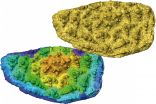(Press-News.org) South African and Argentinian palaeontologists have discovered a new 200 million year old dinosaur from South Africa, and named it Sefapanosaurus, from the Sesotho word "sefapano".
The researchers from South Africa's University of Cape Town (UCT) and the University of the Witwatersrand (Wits University), and from the Argentinian Museo de La Plata and Museo Paleontológico Egidio Feruglio made the announcement in the scientific journal, Zoological Journal of the Linnaean Society. The paper, titled: A new basal sauropodiform from South Africa and the phylogenetic relationships of basal sauropodomorphs, was published online on Tuesday, 23 June 2015.
The specimen was found in the late 1930s in the Zastron area of South Africa's Free State province, about 30km from the Lesotho border. For many years it remained hidden among the largest fossil collection in South Africa at the Evolutionary Studies Institute (ESI) at Wits University.
A few years ago it was studied and considered to represent the remains of another South African dinosaur, Aardonyx. However, upon further study, close scrutiny of the fossilised bones has revealed that it is a completely new dinosaur.
One of the most distinctive features is that one of its ankle bones, the astragalus, is shaped like a cross. Considering the area where the fossil was discovered, the researchers aptly named the new dinosaur, Sefapanosaurus, after the Sesotho word "sefapano", meaning "cross".
Anusuya Chinsamy-Turan, co-author and Professor in the Department of Biological Sciences at UCT, says: "The discovery of Sefapanosaurus shows that there were several of these transitional early sauropodomorph dinosaurs roaming around southern Africa about 200 million years ago."
Dr Alejandro Otero, Argentinian palaeontologist and lead author, says Sefapanosaurus helps to fill the gap between the earliest sauropodomorphs and the gigantic sauropods. "Sefapanosaurus constitutes a member of the growing list of transitional sauropodomorph dinosaurs from Argentina and South Africa that are increasingly telling us about how they diversified."
Says Dr Jonah Choiniere, co-author and Senior Researcher in Dinosaur Palaeobiology at the ESI at Wits University: "This new animal shines a spotlight on southern Africa and shows us just how much more we have to learn about the ecosystems of the past, even here in our own 'backyard'. And it also gives us hope that this is the start of many such collaborative palaeo-research projects between South Africa and Argentina that could yield more such remarkable discoveries."
Argentinian co-author, Dr Diego Pol, says Sefapanosaurus and other recent dinosaur discoveries in the two countries reveal that the diversity of herbivorous dinosaurs in Africa and South America was remarkably high back in the Jurassic, about 190 million years ago when the southern hemisphere continents were a single supercontinent known as Gondwana.
Finding a new dinosaur among old bones
Otero and Emil Krupandan, PhD-student from UCT, were visiting the ESI collections to look at early sauropodomorph dinosaurs when they noticed bones that were distinctive from the other dinosaurs they were studying.
Krupandan was working on a dinosaur from Lesotho as part of his studies when he realised the material he was looking at was different to Aardonyx. "This find indicates the importance of relooking at old material that has only been cursorily studied in the past, in order to re-evaluate past preconceptions about sauropodomorph diversity in light of new data."
The remains of the Sefapanosaurus include limb bones, foot bones, and several vertebrae. Sefapanosaurus is represented by the remains of at least four individuals in the ESI collections at Wits University. It is considered to be a medium-sized sauropodomorph dinosaur - among the early members of the group that gave rise to the later long necked giants of the Mesozoic.
INFORMATION:
Boulder, Colo. -- The 26 December 2004 Mw ~9.2 Indian Ocean earthquake (also known as the Sumatra-Andaman or Aceh-Andaman earthquake), which generated massive, destructive tsunamis, especially along the Aceh coast of northern Sumatra, Indonesia, clearly demonstrated the need for a better understanding of how frequently subduction zone earthquakes and tsunamis occur. Toward that end, Harvey M. Kelsey of Humboldt State University and colleagues present a study of earthquake history in the area.
Using subsidence stratigraphy, the team traced the different modes of coastal ...
The tooth plate of just some millimeters in size had been in a box for more than 40 years, without being recognized after the discovery and preparation of the fish it belonged to. Palaeontologists from Naturalis Biodiversity Center, Netherlands and the University of Bristol, United Kingdom, studied the fossil using high energy X-rays at the Swiss Light Source at the Paul Scherrer Institut in Switzerland, revealing the structure and development of teeth and bones. Their findings are published today in Biology Letters.
Teeth are important in our daily life, they are crucial ...
A digital map of the ageing brain could aid the diagnosis of Alzheimer's disease and other neurodegenerative disorders in older people, a study suggests.
The atlas created using images from MRI scans of older people could aid diagnosis by comparing the patients' scans with a detailed map of the healthy ageing brain.
Most existing MRI atlases are based on the brains of young and middle-aged people, which don't reflect the normal changes that take place in the brain as we age, the team says.
Researchers at the University of Edinburgh constructed a detailed atlas of ...
Various diagnostic imaging techniques are currently used for clinical imaging/disease diagnosis. The accuracy of diagnosis is mainly based on the type of energy used (such as X-ray, sound waves, photons and positrons) to derive the visual information, as well as the degree of spatial resolution (mesoscopic or microscopic) and the level of information that can be obtained (physiological, anatomical or molecular). Based on potential health hazards imposed by type of energy used, clinical imaging modalities can be broadly categorized as ionizing and non-ionizing modalities. ...
Milan, Italy - 24 June 2015: Uninterrupted treatment with novel oral anticoagulants (NOACs) during catheter ablation of atrial fibrillation (AF) is safe, reveals research presented today at EHRA EUROPACE - CARDIOSTIM 2015 by Dr Carsten Wunderlich, senior consultant in the Department of Invasive Electrophysiology, Heart Centre Dresden, Germany.1 Continuation of NOAC therapy was not associated with periprocedural bleeding or thromboembolic complications.
The joint meeting of the European Heart Rhythm Association (EHRA) of the European Society of Cardiology (ESC) and Cardiostim ...
TORONTO, ON - Adults who were exposed to childhood adversity, including witnessing parental domestic violence, childhood physical and sexual abuse have higher odds of experiencing migraine headaches in adulthood, according to a new study from researchers at the University of Toronto.
"We found the more types of violence the individual had been exposed to during their childhood, the greater the odds of migraine. For those who reported all three types of adversities--parental domestic violence, childhood physical and sexual abuse--the odds of migraine were a little over ...
Scientists have demonstrated for the first time the ability to rapidly, reliably and simultaneously identify the 'handedness' of different molecules in a mixture.
The research, led by chemists at The University of Nottingham and the VU University Amsterdam, and published in the academic journal Nature Communications, could offer a new technique to easily distinguish whether a molecule is present in a left- or right-handed form.
The breakthrough could be important in developing effective molecules for use in a wide range of industries -- everything from the development ...
Piscataway, N.J. -- A form of 'virtual-reality' therapy may help people with alcohol dependence reduce their craving for alcohol, a new study suggests.
The findings, published in the July issue of the Journal of Studies on Alcohol and Drugs, come from a small study of just 10 patients. But researchers said they are optimistic about the potential for virtual reality as a therapy for alcohol use disorders.
'This technology is already popular in the fields of psychology and psychiatry,' said senior researcher Doug Hyun Han, M.D., Ph.D., of Chung-Ang University Hospital ...
Changes in the gut bacteria of colon cancer patients indicate that some virulent bacteria could be linked to the progression of the disease, according to research published in the open access journal Genome Medicine. The findings could eventually be used to identify a virulence signature in these cancers and help doctors predict how bacterial changes in patients' guts could affect their prognosis.
The human gut microbiome, the collection of microorganisms, their genomes and habitat that contributes to maintaining a healthy intestine, is thought to play an active role ...
Despite a general consensus among scientists and in the racing industry that racehorse speed has plateaued, a new study from the University of Exeter has found that racehorses are getting quicker. Further research is required to determine whether the increased speeds have a genetic basis or are the result of improved training, jockey tactics or other environmental factors.
It had appeared that racehorse speeds were not improving and previous studies concluded that thoroughbred racehorses may have reached the limits of their abilities. However these studies only analysed ...

